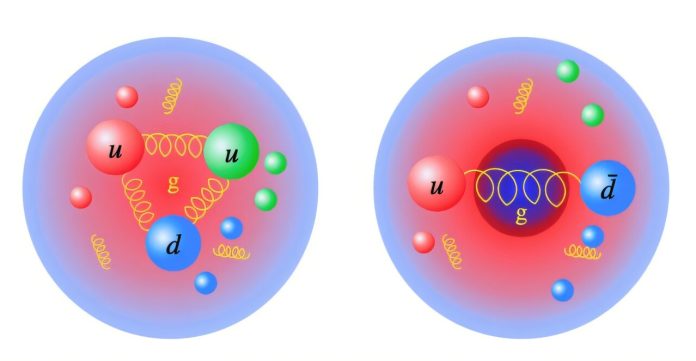
Scientists have uncovered new details about how mass is distributed inside tiny particles called hadrons, such as protons, neutrons, and pions.
These findings, published in Physical Review D, help us better understand the fundamental particles that make up everything in the universe.
Hadrons are made of even smaller particles called quarks, which are held together by a powerful force carried by gluons.
To study the mass of these particles, scientists analyze their energy and momentum in a four-dimensional framework called spacetime.
A key factor in this study is something called the trace anomaly, which reveals how mass and energy behave at different scales.
The research team calculated the trace anomaly for both nucleons (protons and neutrons) and pions (particles made of one quark and one antiquark). The results showed some interesting patterns:
- In nucleons, the mass distribution mirrors the charge distribution of protons.
- In pions, the mass distribution is similar to the charge distribution of neutrons.
These findings hint at deeper connections between mass, charge, and the forces that hold particles together.
One major goal of this research is to understand the origin of nucleon mass. Scientists also want to explore how mass from quarks and gluons is distributed within hadrons. These questions are central to the work being planned at the Electron-Ion Collider (EIC), a cutting-edge facility under development at Brookhaven National Laboratory.
Future experiments at the EIC will involve shooting electrons at protons to study their internal structure. When the electrons scatter off the protons, they will reveal details about how gluons—the particles responsible for the strong force—contribute to the mass of hadrons. This process is similar to how X-ray diffraction helped scientists discover the double-helix structure of DNA.
The new study provides a method for calculating mass distribution based on fundamental physical laws. These calculations will help scientists interpret data from experiments and refine their understanding of how the Standard Model of physics explains the universe.
One exciting discovery is the role of the pion, a particle that connects two important ideas in the Standard Model: the presence of an absolute energy scale and the asymmetry between left-handed and right-handed particles. By studying the pion’s structure, scientists hope to uncover new links between these properties and gain further insight into the building blocks of matter.
These findings mark a step forward in understanding the hidden dynamics of mass in the tiniest particles, bringing us closer to answering some of the biggest questions in physics.



